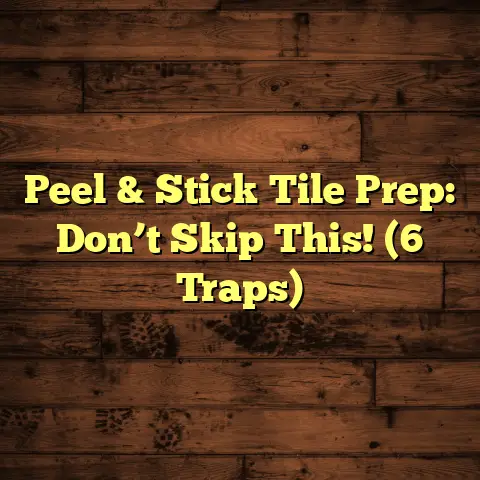Lifeproof Flooring: How Long? (2 Year Warning!)
Lifeproof flooring is marketed as incredibly durable and waterproof, but how long does Lifeproof flooring actually last?
And what’s this “2 Year Warning” you might have heard about?
Trust me, understanding the longevity of your flooring before you buy is crucial. Let’s get started!
Understanding Lifeproof Flooring
So, what exactly is Lifeproof flooring?
Essentially, it’s a type of resilient flooring typically made from multiple layers of vinyl or a composite core.
It’s designed to mimic the look of hardwood, tile, or stone, but with enhanced durability and water resistance.
Think of it as the superhero version of your standard vinyl flooring.
The magic of Lifeproof lies in its construction. It’s often composed of:
-
A wear layer: This is the top layer, protecting against scratches, scuffs, and stains.
-
A decorative layer: This is where the beautiful design comes in, mimicking wood grain or tile patterns.
-
A core layer: This is usually a waterproof vinyl or composite core, providing stability and preventing water damage.
-
An underlayment (sometimes): This layer provides cushioning and sound absorption.
Lifeproof flooring is available in a wide range of styles and designs. From rustic wood planks to modern tile looks, you’re bound to find something that fits your aesthetic.
I’ve installed Lifeproof in countless homes, and clients are often drawn to its combination of beauty and practicality.
Durability and Longevity Factors
Now, let’s get down to brass tacks: how long can you expect Lifeproof flooring to last?
Under normal residential conditions, Lifeproof flooring is generally expected to last anywhere from 10 to 25 years.
However, several factors can significantly impact its lifespan.
Let’s break down the key culprits:
-
Quality of Installation: This is HUGE.
A poorly installed floor is a recipe for disaster.
Gaps, uneven subfloors, or incorrect locking mechanisms can lead to premature wear, buckling, and water damage.
I always tell my clients: “You can buy the best flooring in the world, but if it’s not installed properly, it’s not going to last.”
Proper installation techniques, including preparing the subfloor and using the right tools, are essential.
-
Environmental Conditions: Your home’s environment plays a crucial role.
Excessive humidity can cause the flooring to expand and contract, leading to warping.
Direct sunlight can fade the color over time.
Temperature fluctuations can also stress the material.
Controlling your home’s climate is key to maximizing your floor’s lifespan.
-
Foot Traffic: This one’s pretty obvious.
A floor in a busy hallway will experience more wear and tear than one in a guest bedroom.
Heavy foot traffic, especially with pets or kids, can accelerate the wear of the wear layer.
Consider the traffic levels in different areas of your home when choosing your flooring.
To illustrate the impact of these factors, here’s a simplified table:
| Factor | Impact on Lifespan |
|---|---|
| Poor Installation | Can reduce lifespan by 5-10 years or more. |
| High Humidity | Can lead to warping and reduce lifespan by 3-7 years. |
| Direct Sunlight | Can cause fading and reduce lifespan by 2-5 years. |
| Heavy Foot Traffic | Can accelerate wear and tear, reducing lifespan by 3-5 years. |
The 2 Year Warning: What Homeowners Need to Know
Okay, let’s address the elephant in the room: the “2 Year Warning.”
What’s the deal with that?
While Lifeproof flooring is designed to be durable, some homeowners have reported issues within the first two years of installation.
These problems often stem from a combination of the factors I mentioned earlier: poor installation, environmental conditions, and usage.
Here are some specific problems that users may encounter:
-
Warping or Buckling: This is often caused by moisture issues.
If moisture seeps under the flooring (due to improper installation or a leak), it can cause the planks to warp or buckle.
I’ve seen this happen in bathrooms and kitchens where spills aren’t cleaned up promptly.
-
Scratches and Dents: While Lifeproof is scratch-resistant, it’s not scratch-proof.
Heavy objects, dragging furniture, or pets with sharp claws can still cause scratches and dents.
I’ve had clients complain about scratches from their dog’s nails, even with regular nail trimming.
-
Fading or Discoloration: Prolonged exposure to direct sunlight can cause the flooring to fade or discolor over time.
This is especially noticeable in rooms with large windows.
I’ve seen cases where the flooring under a rug is a different color than the exposed areas.
I’ve personally encountered several cases where Lifeproof flooring developed issues within the first two years.
One client had warping in their kitchen due to a leaky dishwasher that wasn’t addressed promptly.
Another client experienced significant scratching from their large dog, despite the flooring being marketed as “pet-proof.”
These experiences highlight the importance of proper installation, environmental control, and proactive maintenance.
Maintenance and Care Tips
Fortunately, you can take steps to maximize the longevity of your Lifeproof flooring and avoid the dreaded “2 Year Warning.”
Here’s a comprehensive guide to maintenance and care:
-
Regular Cleaning: Sweep or vacuum your floor regularly to remove dirt, dust, and debris.
Use a soft-bristled broom or a vacuum with a hard floor attachment.
Avoid using vacuums with beater bars, as they can scratch the surface.
-
Damp Mopping: Mop your floor with a damp mop and a pH-neutral cleaner specifically designed for vinyl flooring.
Avoid using excessive water, as it can seep into the seams and cause damage.
I recommend using a microfiber mop for best results.
-
Spill Cleanup: Clean up spills immediately to prevent staining or water damage.
Use a clean, dry cloth to blot the spill.
Avoid rubbing, as this can spread the stain.
-
Protective Mats and Pads: Place mats at entrances to trap dirt and debris.
Use furniture pads under the legs of furniture to prevent scratches and dents.
-
Avoid Harsh Chemicals: Avoid using harsh chemicals, abrasive cleaners, or scouring pads, as they can damage the wear layer.
-
Sun Protection: Use curtains or blinds to protect your floor from direct sunlight.
-
Regular Inspections: Inspect your floor regularly for signs of wear and tear, such as scratches, dents, or warping.
Address any issues promptly to prevent them from worsening.
Here’s a quick reference table for cleaning products:
| Issue | Recommended Cleaning Product |
|---|---|
| General Cleaning | pH-neutral vinyl floor cleaner |
| Stains | Mild dish soap and water |
| Scratches | Scratch repair kit for vinyl flooring (use sparingly) |
Comparative Analysis with Other Flooring Options
How does Lifeproof flooring stack up against other popular options?
Let’s take a look:
-
Hardwood: Hardwood is beautiful and adds value to your home, but it’s also expensive and requires more maintenance.
It’s susceptible to water damage and scratches.
Lifeproof offers a similar look with greater durability and water resistance at a lower cost.
-
Tile: Tile is durable and water-resistant, but it can be cold and hard underfoot.
It can also be expensive to install.
Lifeproof offers a warmer, more comfortable alternative with easier installation.
-
Carpet: Carpet is soft and comfortable, but it’s also prone to stains and allergens.
It requires regular cleaning and may need to be replaced more frequently.
Lifeproof offers a more durable and hygienic option, especially for homes with pets or kids.
Here’s a table summarizing the pros and cons:
| Flooring Type | Pros | Cons |
|---|---|---|
| Lifeproof | Durable, water-resistant, affordable, easy to install, wide range of styles | Can feel less luxurious than hardwood or tile, can be susceptible to scratches with heavy use |
| Hardwood | Beautiful, adds value, classic look | Expensive, requires more maintenance, susceptible to water damage and scratches |
| Tile | Durable, water-resistant, easy to clean | Cold and hard underfoot, can be expensive to install |
| Carpet | Soft and comfortable, absorbs sound | Prone to stains and allergens, requires regular cleaning, may need to be replaced more frequently |
Lifeproof flooring is an excellent choice for homeowners who want a durable, water-resistant, and affordable flooring option.
It’s particularly well-suited for:
- Homes with pets or kids
- Bathrooms and kitchens
- Basements
- High-traffic areas
However, if you’re looking for the ultimate in luxury and are willing to invest in more maintenance, hardwood or high-end tile may be a better choice.
Conclusion
So, how long does Lifeproof flooring last?
With proper installation and maintenance, you can expect it to last anywhere from 10 to 25 years.
However, it’s crucial to be aware of the “2 Year Warning” and take steps to prevent common issues like warping, scratching, and fading.
Remember, proper installation, environmental control, and proactive maintenance are key to maximizing the longevity of your Lifeproof flooring.
Make an informed decision based on your specific needs and circumstances.
Don’t be afraid to ask questions and seek professional advice.
Your floors are a significant investment, so make sure you choose wisely!





